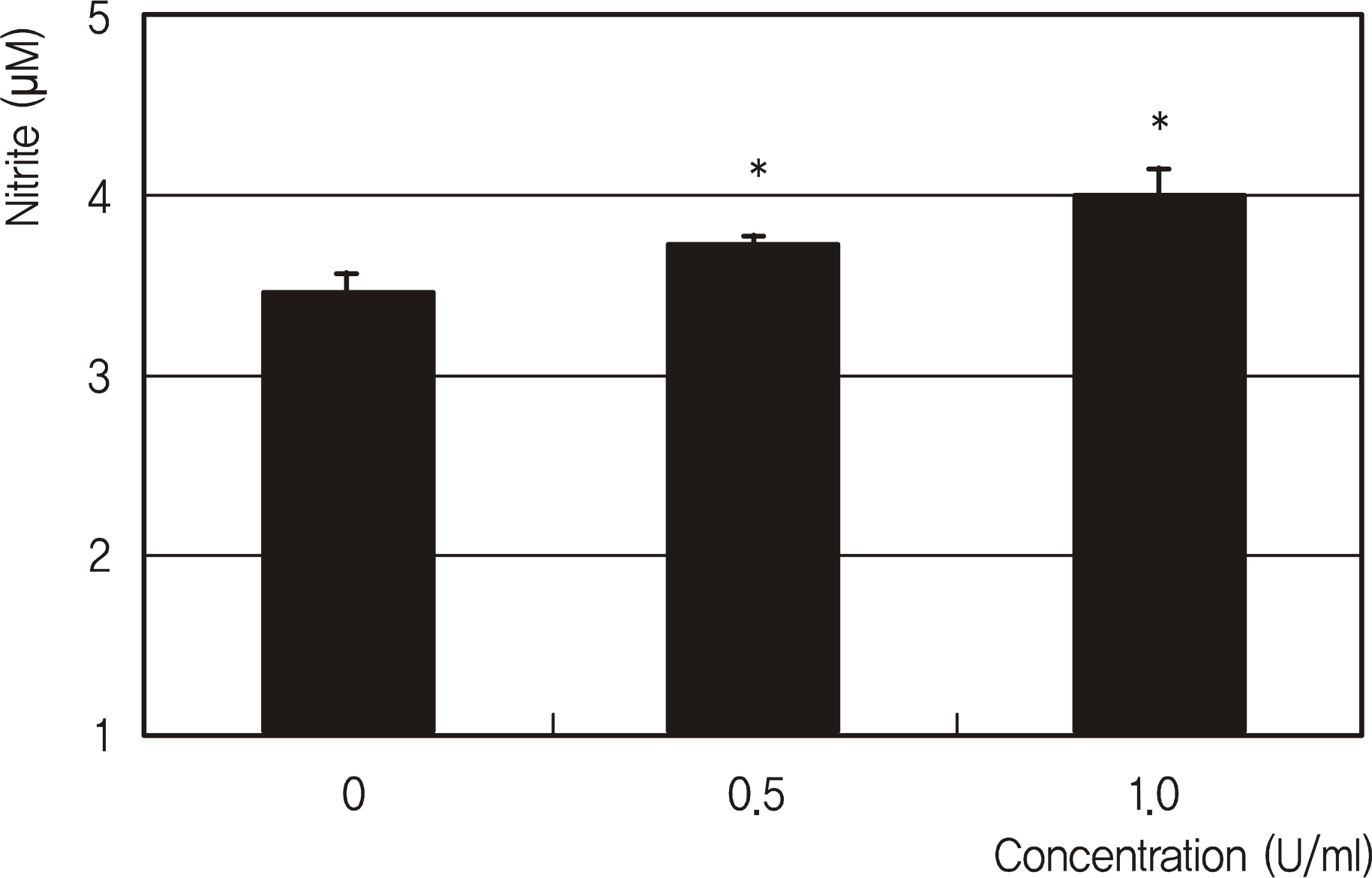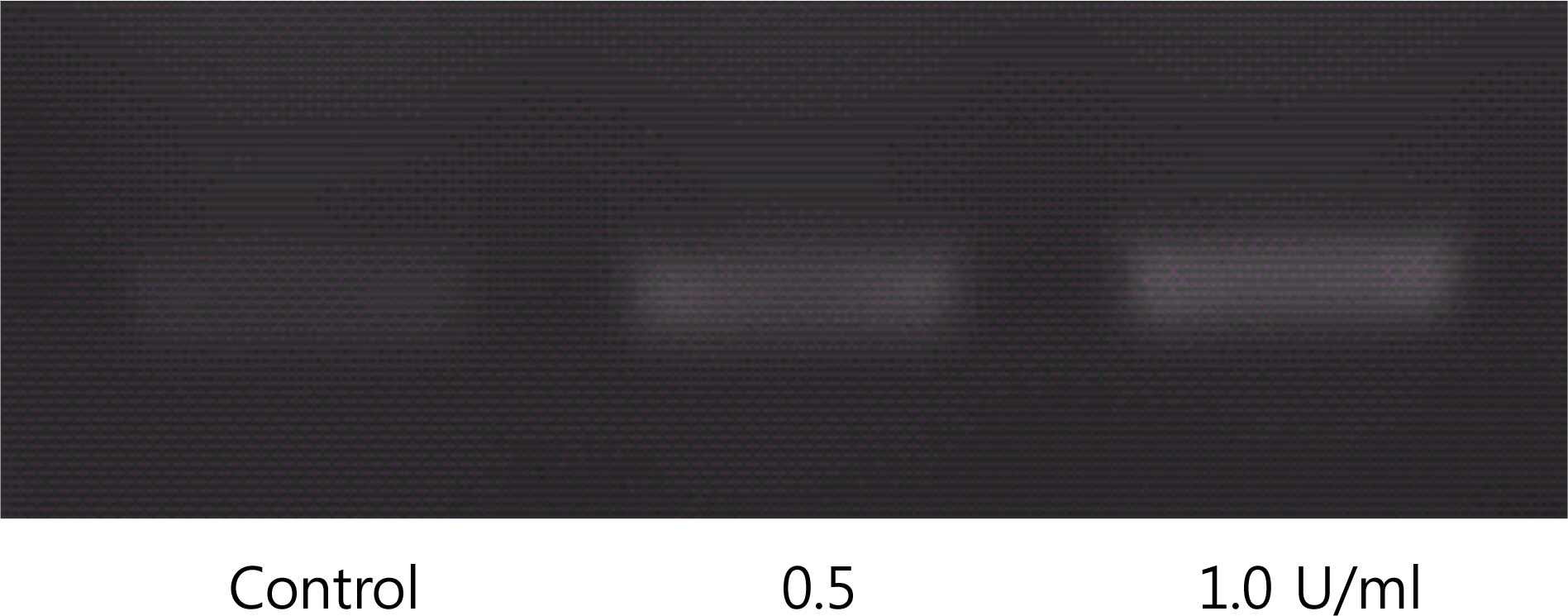J Korean Ophthalmol Soc.
2011 Dec;52(12):1514-1518. 10.3341/jkos.2011.52.12.1514.
Effect of Erythropoietin on the Production of Nitric Oxide in Trabecular Meshwork Cells
- Affiliations
-
- 1Department of Ophthalmology, Catholic University of Daegu College of Medicine, Daegu, Korea. jwkim@cu.ac.kr
- KMID: 2215158
- DOI: http://doi.org/10.3341/jkos.2011.52.12.1514
Abstract
- PURPOSE
To investigate the effects of erythropoietin (EPO) on the production of nitric oxide in cultured human trabecular meshwork cells (HTMC).
METHODS
Primarily cultured HTMC were exposed to 0, 0.5, and 1.0 U/ml EPO using serum-deprived media for 2 days. Production of nitric oxide and cellular survival were assessed with Griess assay and MTT assay, respectively. Expression of EPO mRNA receptor and activity of eNOS were assessed with RT-PCR.
RESULTS
EPO did not affect the survival of HTMC (p > 0.05). EPO increased the production of nitric oxide (p < 0.05) accompanied with increased eNOS activity.
CONCLUSIONS
EPO had no effect on the cellular survival under serum-deprived conditions. EPO increases the production of nitric oxide by increasing eNOS activity.
MeSH Terms
Figure
Cited by 1 articles
-
Effect of Dipyridamole on the Reactive Oxygen Species and Oxidative Stress in Trabecular Meshwork Cells
Keun Woo Lee, Jae Woo Kim
J Korean Ophthalmol Soc. 2013;54(3):496-501. doi: 10.3341/jkos.2013.54.3.496.
Reference
-
References
1. Alvarado J, Murphy C, Juster R. Trabecular meshwork cellularity in primary openangle glaucoma and nonglaucomatous normals. Ophthalmology. 1984; 91:564–79.
Article2. Rohen JW, Lütjen-Drecoll E, Flügel C, et al. Ultrastructure of the trabecular meshwork in untreated cases of primary openangle glaucoma (POAG). Exp Eye Res. 1993; 56:683–92.3. Wiederholt M, Dorschner N, Groth J. Effect of diuretics, channel modulators, and signal interceptors on contractility of the trabecular meshwork. Ophthalmologica. 1997; 211:153–60.
Article4. Wiederholt M, Stumpff F. The trabecular meshwork and aqueous humor reabsorption. Civan MM, editor. Current Topics in Membranes. The Eye's Aqueous Humor: From Secretion to Glaucoma. 45. San Diego: Academic Press;1998. p. 163–202.5. Wiederholt M, Sturm A, Lepple-Wienhues A. Relaxation of trabecular meshwork and ciliary muscle by release of nitric oxide. Invest Ophthalmol Vis Sci. 1994; 35:2515–20.6. Behar-Cohen FF, Goureau O, D'Hermies F, Courtois Y. Decreased intraocular pressure induced by nitric oxide donors is correlated to nitrite production in the rabbit eye. Invest Ophthalmol Vis Sci. 1996; 37:1711–5.7. Fandrey J. Oxygen-dependent and tissue-specific regulation of erythropoietin gene expression. Am J Physiol Regul Integr Comp Physiol. 2004; 286:R977–88.
Article8. Siren AL, Fratelli M, Brines M, et al. Erythropoietin prevents neu-ronal apoptosis after cerebral ischemia and metabolic stress. Proc Natl Acad Sci USA. 2001; 98:4044–9.
Article9. Carlini RG, Alonzo EJ, Dominguez J, et al. Effect of recombinant human erythropoietin on endothelial cell apoptosis. Kidney Int. 1999; 55:546–53.
Article10. Akimoto T, Kusano E, Inaba T, et al. Erythropoietin regulates vascular smooth muscle cell apoptosis by a phosphatidylinositol 3 kinase-dependent pathway. Kidney Int. 2000; 58:269–82.
Article11. Rui T, Feng Q, Lei M, et al. Erythropoietin prevents the acute my-ocardial inflammatory response induced by ischemia/reperfusion via induction of AP-1. Cardiovasc Res. 2005; 65:719–27.
Article12. Burger D, Lei M, Geoghegan-Morphet N, et al. Erythropoietin protects cardiomyocytes from apoptosis via up-regulation of endothelial nitric oxide synthase. Cardiovasc Res. 2006; 72:51–9.
Article13. Garcia-Ramirez M, Hernandez C, Simo R. Expression of Erythropoietin and Its Receptor in the Human Retina: comparative study of diabetic and nondiabetic subjects. Diabetes Care. 2008; 31:1189–94.14. Tsai JC, Song BJ, Wu L, Forbes M. Erythropoietin: A candidate neuroprotective agent in the treatment of glaucoma. J Glaucoma. 2007; 16:567–71.
Article15. Mosmann T. Rapid colorimetric assay for cellular growth and survival: application to proliferation and cytotoxicity assays. J Immunol Methods. 1983; 65:55–63.
Article16. Freimoser FM, Jakob CA, Aebi M, Tuor U. The MTT [3-(4,5-di-methylthiazol-2-yl)-2,5-diphenyltetrazolium bromide] assay is a fast and reliable method for colorimetric determination of fungal cell densities. Appl Environ Microbiol. 1999; 65:3727–9.
Article17. Green LC, Wagner DA, Glogowski J, et al. Analysis of Nitrate, Nitrite and [15N]Nitrate in biological fluids. Anal Biochem. 1982; 126:131–8.
Article18. Smith KJ, Bleyer AJ, Little WC, Sane DC. The cardiovascular effects of erythropoietin. Cardiovasc Res. 2003; 59:538–48.
Article19. Santhanam AV, Smith LA, Akiyama M, et al. Role of endothelial NO synthase phosphorylation in cerebrovascular protective effect of recombinant erythropoietin during subarachnoid hemorrhage-induced cerebral vasospasm. Stroke. 2005; 36:2731–7.20. Urao N, Okigaki M, Yamada H, et al. Erythropoietin-mobilized endothelial progenitors enhance reendothelialization via Akt-endothelial nitric oxide synthase activation and prevent neointimal hyperplasia. Circ Res. 2006; 98:1405–13.
Article21. d'Uscio LV, Smith LA, Santhanam AV, et al. Essential role of endothelial nitric oxide synthase in vascular effects of erythropoietin. Hypertension. 2007; 49:1142–8.22. d'Uscio LV, Katusic ZS. Erythropoietin increases endothelial bio-synthesis of tetrahydrobiopterin by activation of protein kinase B alpha/Akt1. Hypertension. 2008; 52:93–9.23. d'Uscio LV, Smith LA, Katusic ZS. Erythropoietin increases expression and function of vascular copper- and zinc-containing su-peroxide dismutase. Hypertension. 2010; 55:998–1004.24. Wang XQ, Vaziri ND. Erythropoietin depresses nitric oxide synthase expression by human endothelial cells. Hypertension. 1999; 33:894–9.
Article25. Mokbel TH, Ghanem AA, Kishk H, et al. Erythropoietin and soluble CD44 levels in patients with primary openangle glaucoma. Clin Experiment Ophthalmol. 2010; 38:560–5.
Article26. Kawakami M, Sekiguchi M, Sato K, et al. Erythropoietin re-ceptor-mediated inhibition of exocytotic glutamate release confers neuroprotection during chemical ischemia. J Biol Chem. 2001; 276:39469–75.
Article27. Arjamaa O, Nikinmaa M. Oxygen-dependent diseases in the retina: role of hypoxia-inducible factors. Exp Eye Res. 2006; 83:473–83.
Article28. Milano M, Collomp R. Erythropoietin and neuroprotection: a therapeutic perspective. J Oncol Pharm Pract. 2005; 11:145–9.
Article29. Zhong Y, Yao H, Deng L, et al. Promotion of neurite outgrowth and protective effect of erythropoietin on the retinal neurons of rats. Graefes Arch Clin Exp Ophthalmol. 2007; 245:1859–67.
Article
- Full Text Links
- Actions
-
Cited
- CITED
-
- Close
- Share
- Similar articles
-
- Effect of Mitomycin C on the Proliferation and Nitric Oxide Production in the Cultured Trabecular Meshwork Cells
- Effect of beta-adrenergics on the Survival and Production of Nitric Oxide in the Cultured Trabecular Meshwork Cells
- A Study of the Pathway of Nitric Oxide Production by Nitroglycerin in Trabecular Meshwork Cells
- The Effects of Topical Carbonic Anhydrase Inhibitors on Nitric Oxide Production in Trabecular Meshwork Cells
- Effect of Genistein on the Survival and Production of Nitric Oxide in Trabecular Meshwork Cells





